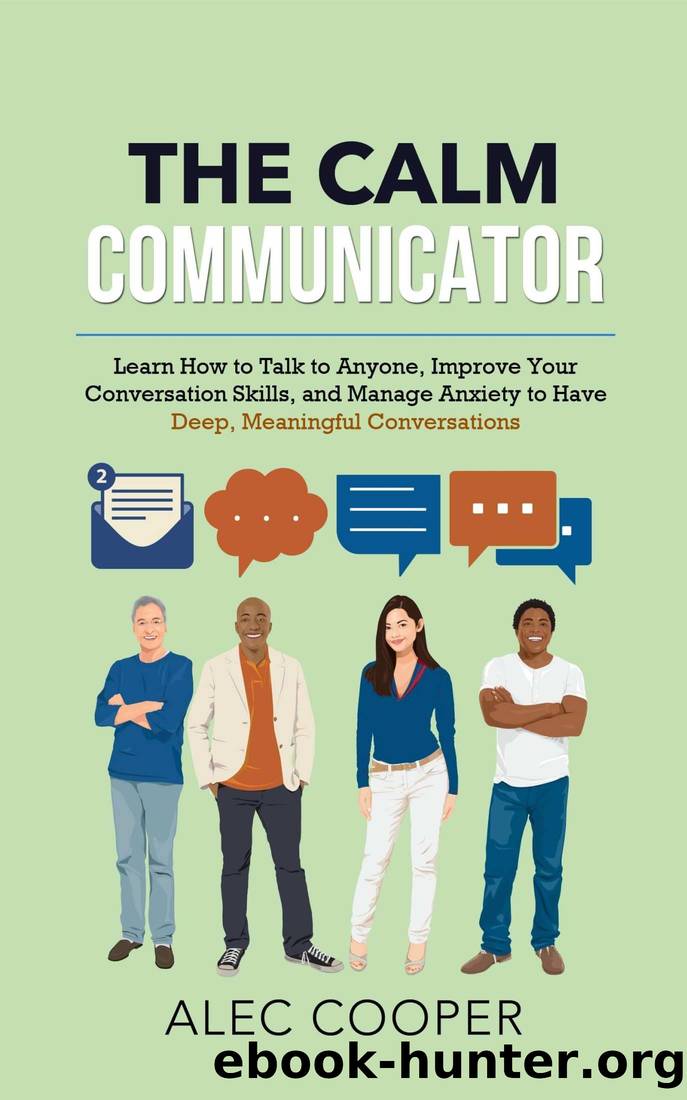The Calm Communicator: Learn How to Talk to Anyone, Improve Your Conversation Skills, and Manage Anxiety to Have Deep, Meaningful Conversations by Alec Cooper

Author:Alec Cooper
Language: eng
Format: azw3, pdf
Published: 2023-05-13T05:00:00+00:00
Components of Nonverbal Communication
Non-verbal communication, perhaps because it doesn't involve words, needs to be more simplified. As mentioned previously, non-verbal communication impacts your ability to communicate more than verbal communication. Despite some people underwhelming the intricacies of non-verbal communication, there are several key areas where the expert communicator should focus:
â Eye gaze: As cliché as it might sound, our eyes indeed are the windows to our soul. You must have heard thisâIf you want to know how someone truly feels about you, you only have to look at their eyes. Some might say that this is a simplistic view of things. After all, some of us are too shy to be able to hold eye contact with people for extended periods. Others can stare directly at someone's eyes and lie to them (more on this soon). Still, there are many cues you can get from looking at someone's eyes. For example, you can see whether they're surprised, angry, or even attracted to you. Generally, people who can hold steady eye contact with others are perceived as trustworthy and transparent. Similarly, when you like someone, your pupils become dilated.
â Facial cues: Facial cues are almost entirely universal. For example, a smile is a smile no matter where you're from. Similarly, a frown can tell you that someone is upset with you, and a shrug can imply that the other person is uninterested. Sometimes, these facial cues can be easy to understand. Other times, you might have to pay attention to know what they're conveying. For example, one way to spot whether someone is truly happy is to see if their smile spreads to their eyes. Similarly, some people might control their expressions well, but their jaws might clench slightly, revealing their anger or frustration.
â Body language: Our body language can convey a lot about our feelings. They can also affect how others around us feel. For example, body language that conveys stress can make others feel anxious. Conversely, if a person around us seems relaxed, we can relax in their presence. Indeed, we may be sending the wrong signals through our body language. For example, we might be extremely friendly, but our demeanor might make others feel intimidated around us. Similarly, we might habitually fidget occasionally, making people think we're bored or irritated. Since body language is one of the first things anyone notices, it's a good idea to be mindful of it as much as possible.
â Appearance: Imagine you're invited to an interview or meeting someone for the first time. Even before you've said a word, the other person appraises you based on your appearance. Of course, some things are peculiar to different cultures. For example, some cultures require you to dress more modestly, while others have an ideal body type. However, one thing that is appreciated almost universally is a neat appearance. You don't need to shop at expensive locations or go overboard, but it should seem like you've made an effort.
â Gestures: A gesture is usually a movement our hands make to convey a message to someone else.
Download
The Calm Communicator: Learn How to Talk to Anyone, Improve Your Conversation Skills, and Manage Anxiety to Have Deep, Meaningful Conversations by Alec Cooper.pdf
This site does not store any files on its server. We only index and link to content provided by other sites. Please contact the content providers to delete copyright contents if any and email us, we'll remove relevant links or contents immediately.
| Bookkeeping | Business Mathematics |
| Business Writing | Communications |
| Decision Making | Negotiating |
| Project Management | Running Meetings & Presentations |
| Secretarial Aids & Training | Time Management |
| Training |
Nudge - Improving Decisions about Health, Wealth, and Happiness by Thaler Sunstein(7622)
Deep Work by Cal Newport(6884)
Principles: Life and Work by Ray Dalio(6220)
Factfulness: Ten Reasons We're Wrong About the World – and Why Things Are Better Than You Think by Hans Rosling(4694)
The Doodle Revolution by Sunni Brown(4689)
Eat That Frog! by Brian Tracy(4436)
Thinking in Bets by Annie Duke(4153)
Hyperfocus by Chris Bailey(4052)
Visual Intelligence by Amy E. Herman(3724)
Writing Your Dissertation in Fifteen Minutes a Day by Joan Bolker(3670)
Ogilvy on Advertising by David Ogilvy(3512)
How to Win Friends and Influence People in the Digital Age by Dale Carnegie & Associates(3497)
Hidden Persuasion: 33 psychological influence techniques in advertising by Marc Andrews & Matthijs van Leeuwen & Rick van Baaren(3474)
How to win friends and influence people by Dale Carnegie(3400)
The Pixar Touch by David A. Price(3364)
Schaum's Quick Guide to Writing Great Short Stories by Margaret Lucke(3321)
Deep Work: Rules for Focused Success in a Distracted World by Cal Newport(3147)
Work Clean by Dan Charnas(3051)
The Slow Fix: Solve Problems, Work Smarter, and Live Better In a World Addicted to Speed by Carl Honore(2947)
